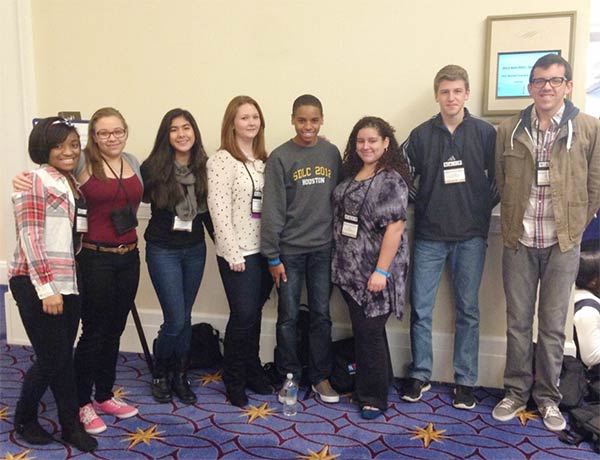Six students from Moorestown Friends School attended the Student Diversity Leadership Conference in National Harbor, MD, from December 5 to 7, 2013: Andayah Sams, Nicole Briones, Mia Zayas, Molly Fischer, Leon Pfeiffer, and Spencer Kelly. Ten faculty members accompanied them to attend the concurrent People of Color Conference.
Hosted by the National Association of Independent Schools (NAIS), The Student Diversity Leadership Conference is a multiracial, multicultural gathering of upper school student leaders from around the country. Participants examine issues of social justice, develop effective cross-cultural communication skills, practice expression through the arts, and learn networking principles and strategies.
“We talked about the six core cultural identifiers: sexual orientation, gender, race, socioeconomic status, ability, and religion,” said Kelly, who also attended the conference in 2012. “My favorite discussion this year was about ability. When I think about ability, I think about what you can do physically. We talked about emotional, mental, and learning disabilities as well. We played a game called Taboo, where we had to describe a disability without using the first six words that come to mind.”
Kelly said that he became aware of his “tunnel vision” and how he was limited by his own experiences.
“What we found at the end was that we didn’t have the ability to talk about ability,” he said. “I had a hard time getting past those initial definitions… What I learned was that I can’t be open-minded about what I believe and then be narrow-minded about what someone else believes.”
For Nicole Briones, who had not attended the conference in previous years, the experience was exciting and “life-changing.”
“I thought, ‘How can this change my life in two days?’ But it did. I understand better why people are the way that they are. I feel more accepting. The atmosphere was so positive.”
One of the most memorable workshops for Briones was an activity called Racebook, where students split into chosen affinity groups and confronted common stereotypes about their cultures. She said it was helpful for her to reclaim the negative descriptions and reflect on her Ecuadorian and Cuban background.
“I identified as part of the Hispanic and Latina group,” she said. “We were positive about our heritage. We took in the stereotypes of society and asked, ‘Do we really look like this?’ We changed the insults into positive things. We identified as ‘good cooks’ and ‘family oriented’… we watched a video of Latina actresses who have made a difference in the industry.”
Kelly, who worked with the African-American affinity group, helped lead discussions as an official peer facilitator at the conference. He said one of the most interesting discussions was about heterosexism.
“We played Jenga, where we color-coded different blocks representing cultural identifiers — heterosexism was the base of Jenga, and that couldn’t be moved. Sexual orientation, race, and gender were all stacked on top of that… When the tower fell, heterosexism was still at the base. When things fall, we need to build ourselves back up from that. Every society in the world is built differently and it can fall apart differently and build back up differently.”
The students said they were also moved by discussions about socioeconomic background and the difficult financial decisions parents make to ensure a better future for their children. For example, they were put into a scenario where they needed to give up everything in order to pay for an adopted daughter’s education.
“If a disaster happens, how do families rebuild?” asked Kelly. “It’s hard to think about.”
“SDLC was so much in two days,” said Briones. “There were 1400 of us, and I can’t say that one was unaccepting. Everyone was so accepting and so supportive. I want to bring that positive energy back with me.”

